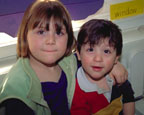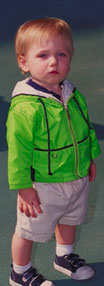 |

Ken Hammond, USDA
The National Child Abuse and Neglect Data System
(NCANDS) is a federally sponsored effort that collects and
analyzes annual data on child abuse and neglect. The data
are submitted voluntarily by the States, the District of Columbia
and the Commonwealth of Puerto Rico. State laws determine
what is considered abuse, maltreatment or neglect in each
state and these laws can vary from state to state. The information
that is collected in each state also varies.
The reader is requested to remember that
the data presented here are provided voluntarily by each state
and compiled by NCANDS. The first report from NCANDS was based
on data for 1990; the most recent report, Child Maltreatment
2008, published in 2010, reports on data collected from
October 1, 2007 through September 30, 2008. Most of the statistics
in this course come from the US Department of Health and Human
Services, Administration for Children and Families' Child
Maltreatment 2008 (USDHHS-ACF, 2010).
The National Picture
For Federal fiscal year 2008, an estimated
3.3 million reports alleging child abuse or neglect were made
to State and local child protective services (CPS) agencies
for investigation or assessment. CPS estimated that 772,000
(10.3 per 1,000) children were victims of maltreatment; approximately
three quarters of them had no history of prior victimization
(CDC, 2010). Note: A child is counted each time she or
he is a subject of a report, which means a child may be counted
more than once as a victim of child maltreatment.
During 2008, 71.1% of victims experienced
neglect, 16.1% were physically abused, 9.1% were sexually
abused, and 7.3% were victims of psychological abuse; 2.2%
experienced medical neglect (CDC, 2010; USDHHS-ACF, 2010).
In addition, 9.0 percent of victims experienced such "other"
types of maltreatment as "abandonment," "threats of harm to
the child," or "congenital drug addiction." States may code
any condition that does not fall into one of the main categories-physical
abuse, neglect, medical neglect, sexual abuse, and psychological
or emotional maltreatment as "other." These maltreatment type
percentages total more than 100 percent because children who
were victims of more than one type of maltreatment were counted
for each maltreatment (USDHHS-ACYF, 2010).
Estimates of child maltreatment vary. According
to Finkelhor, et al. (2009), it is estimated that in 2008,
1 in 5 U.S. children experienced some form of child maltreatment:
approximately 1 percent were victims of sexual assault; 4
percent were victims of child neglect; 9 percent were victims
of physical abuse; and 12 percent were victims of emotional
abuse.
The rate of all children who received a disposition
increased from 43.8 per 1,000 children in 2002 to 49.4 per
1,000 children in 2008. The national estimates are based upon
counting a child each time he or she was the subject of a
CPS investigation. While almost a million children were determined
to be victims of child maltreatment, the rate of victimization
has decreased slightly since 1990. The rate of victimization
per 1,000 children in the national population has dropped
from 13.4 children in 1990 to 12.3 per 1,000 children in 2002
to 10.3 per 1,000 children in 2008 (USDHHS-ACF, 2010; USDHHS-ACF,
2008).
Child fatalities are the most tragic consequence
of maltreatment. In 2008, an estimated 1,740 children ages
0 to 17 died from abuse and neglect (rate of 2.3 per 100,000
children) (CDC, 2010). Nearly 40 percent (39.7%) of fatalities
suffered from multiple forms of maltreatments. Another 30
percent (31.9%) suffered from neglect only; 22.9% of fatalities
were a result of physical abuse; medical neglect resulted
in 1.5% of fatalities.
News reports indicate that in a downturned
economy, as the US has experienced in recent years, both intimate
partner violence/domestic violence and child abuse increases.
If news stories reported in the past 2 years are any indication,
the statistics in the next edition of Child Maltreatment:
2009 should verify this. For example in a sampling
of news stories: MSNBC.com reported on 4/10/09 that hospitals
in New York State are reporting an increase in shaken baby
syndrome cases. They also reported that:
"Eighty-eight percent of law enforcement officials surveyed
nationwide believe the economic crisis has led, or will
lead, to more child abuse and neglect, according to top
police officials from Los Angeles, Boston, Milwaukee and
Philadelphia who recently held a news conference in Washington."
Characteristics
of Child Victims
Generally, the rate of victimization was
inversely related to the age group of the child; the youngest
children had the highest rate of victimization. Children younger
than 4 years are the most vulnerable for many reasons, including
their dependency, small size, and inability to defend themselves
(USDHHS-ACF, 2005). The rate of child victimization for the
age group of birth to 1 year was 21.8 per 1,000 male children
of the same age group. The child victimization rate for girls
in the age group of birth to 1 year was 21.3 per 1,000 female
children of the same age group. The victimization rate for
children in the age group of 4-7 years was 10.9 per 1,000
for both boys and girls. Overall, the victimization rates
decreased for older age groups (USDHHS-ACF, 2010).
Of all the child victims in 2008, the percentage
of children who were under one year of age was 12.3%; 7.2%
were 1 year of age; 6.8% were 2 years of age; 6.3% were 3
years of age. Children 3 and younger accounted for 32.6% of
all children victimized; 23.6% were age 4-7 years; 18.9% were
8-11 years; 18.1% were 12-15 years of age; 6.3% were 16-17
years of age (USDHHS-ACF, 2010).
In 2008, as in previous years, girls were
more likely than boys to be maltreated; 48.3 percent of child
victims were boys, and 51.3 percent of the victims were girls.
The sex of 0.4 percent of child victims was unknown (USDHHS-ACF,
2010).
African-American children, American Indian
or Alaska Native children, and children of multiple races
had the highest rates of victimization at 16.6, 13.9, and
13.8 per 1,000 children of the same race or ethnicity, respectively.
Hispanic children and White children had rates of 9.8 and
8.6 per 1,000 children of the same race or ethnicity, respectively.
Asian children had the lowest rate of 2.4 per 1,000 children
of the same race or ethnicity. Nearly one-half of all victims
were White (45.1%), one-fifth (21.9%) were African-American,
and one-fifth (20.8%) were Hispanic (USDDHS-ACF, 2010).
Child victims who were reported with a disability
accounted for 15% of all victims. Children with the following
risk factors were considered as having a disability: mental
retardation, emotional disturbance, visual or hearing impairment,
learning disability, physical disability, behavioral problems,
or another medical problem. In general, children with such
conditions are undercounted as not every child receives a
clinical diagnostic assessment by CPS agency staff. Approximately
5 percent (5.3%) of victims had behavior problems; 3.7 percent
of victims were emotionally disturbed; another 6.2 percent
had some other medical condition. A victim could have been
reported with more than one type of disability (USDHHS-ACF,
2010).
More than three-quarters (78.0%) of children
who were killed were younger than 4 years of age, 10 percent
were 4-7 years of age, 4 percent were 8-11 years of age, and
6 percent were 12-17 years of age (USDHHS-ACF, 2010). Almost
40% of deaths were non-Hispanic White children; 30% of deaths
were African-American children (CDC, 2010).
Reporters of Child Maltreatment
Professionals submitted more than one-half
(57.9%) of the reports. "Professional" indicates that the
person encountered the alleged victim as part of the report
source's occupation. State laws require most professionals
to notify CPS agencies of suspected maltreatment. Sources
of reports in 2008 were from the following professionals (USDHHS-ACF,
2010):
- Educational personnel (16.9%);
- Legal and law enforcement personnel (16.3%);
- Social services personnel (10.6%);
- Medical personnel (8.3%);
- Mental health personnel (4.3%);
- Child day-care providers (0.9%);
- Foster care providers (0.6%).
Nonprofessional report sources submitted approximately 28
percent of reports. These included parents, other relatives,
friends and neighbors, alleged victims, alleged perpetrators,
and anonymous callers. Anonymous, other relatives, and parents
accounted for the largest groups of nonprofessional reporters.
Unknown or other report sources submitted about 14 percent
of reports (USDHHS-ACF, 2010).
In New York State
The same NCANDS data that provided information for Child
Maltreatment 2008 also provided state-specific information
related to certain categories of information. Much of the
following information has been obtained for New York State
from the same document.
In 2008, 84,089 children were maltreated New York State (USDHHS-ACF,
2010). Of these children (Note: Totals are more than 100
percent because a child may be the victim of more than one
type of maltreatment.):
- 115,098 (136.9%) maltreatments substantiated;
- 77,172 (91.8%) were neglected;
- 8,500 (10.1%) were physically abused;
- 2,733 (3.3%) were sexually abused;
- 703 (0.6%) were psychologically or emotionally maltreated;
- 4,256 (5.1%) were medically neglected; and
- 21,734 (25.8%) other types of maltreatment.
"Other types of maltreatment" include, for example, abandonment,
threats of harm, or congenital drug addiction.
In New York State in 2008, 107 children died as a result
of maltreatment, a fatality rate of 2.43 per 100,000 children.
This is an increase from the fatality rate of 2.16 in 2007
(USDHHS-ACF, 2010).
Of the children who were maltreated in New York State in
2008, 33.8% were White; 28.9% were African-American; 23.7%
were Hispanic; 2.5% were of multiple races; 1.4% were Asian;
and 0.3% were American Indian or Alaskan Native (USDHHS-ACF,
2010).
In New York State, there were a total of 159,556 reports
of child abuse and maltreatment to the State Central Register
(SCR). Of those reports, 59.6% were made by professionals.
Among the following professional groups are the number of
reports and percentage of the total of reports by professional
groups is as follows (USDHHS-ACF, 2010):
- Educational personnel 32,466 (20.3%);
- Law enforcement/legal 17,637 (11.1%);
- Social services personnel 32,688 (20.5%);
- Medical personnel 9,703 (6.1%);
- Child care providers 404 (0.3%);
- Foster care providers 2,104 (1.3%).
The rate of investigations of reports of child abuse or maltreatment
has risen in New York State from 2004 to 2008. In 2004, the
rate was 32.3%; in 2008 it was 36.6% (USDHHS-ACF, 2010).
Of the 159,556 reports of child abuse and maltreatment in
New York State in 2008, 108,567 were determined to have been
unsubstantiated; 50,989 were determined to have been substantiated
(USDHHS-ACF, 2010).

Ken Hammond, USDA
Continue on to
|
 |